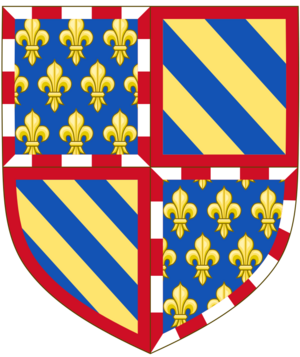History of Burgundy facts for kids

The history of Burgundy is a long and interesting story. This region in France has been home to many different groups of people over time. First came the Celts, then the Romans. In the 5th century, a Germanic group called the Burgundians settled there. They might have come from a place called Bornholm in the Baltic Sea. The Burgundians created their own kingdom in the area.
Later, in the 6th century, another Germanic group called the Franks conquered the Burgundian kingdom. The Franks then ruled Burgundy themselves.
Over time, the region split into two main parts. There was the Duchy of Burgundy in the west and the County of Burgundy in the east. The Duchy of Burgundy is more famous. It later became a French province called Burgundy. The County of Burgundy became another French province called Franche-Comté. This name means "free county."
It can be a bit confusing because many different areas have been called 'Burgundy' throughout history. It's like a puzzle with many pieces! Historians say that few topics in European history are as complicated as "all the Burgundies." There have been many different versions of Burgundy, from the first kingdom in the 5th century to the modern French region we know today.
Contents
The Early Burgundians
The Burgundians were a Germanic people. They likely came from Bornholm, which is now part of Denmark. They moved into the Western Roman Empire as it was weakening.
Around the year 411, the Burgundians crossed the Rhine River. They set up a kingdom in a place called Worms. As the Romans and Huns fought, the Burgundian kingdom grew. It eventually covered parts of what are now Switzerland, France, and Italy. In 534, the Franks defeated Godomar, the last Burgundian king. They then made Burgundy part of their growing empire.
Burgundy in the Middle Ages
After the Frankish Empire broke apart, several different areas were called Burgundy. In the late 800s, there were three main Burgundies:
- The Kingdom of Upper (Transjurane) Burgundy near Lake Geneva.
- The Kingdom of Lower Burgundy in Provence.
- The Duchy of Burgundy west of the Saône River.
In 933, the two kingdoms of Upper and Lower Burgundy joined together. They formed the Kingdom of Burgundy. This kingdom later became part of the Holy Roman Empire in 1032. From the 1100s, it was known as the Kingdom of Arles. The Duchy of Burgundy, however, became part of the French kingdom in 1004.
During the Middle Ages, Burgundy was a very important religious center. Some of the most famous churches and monasteries in Western Europe were there. These included Cluny, Cîteaux, and Vézelay.
The Rise of the Dukes of Burgundy
In the 1100s and 1200s, the County of Burgundy grew. It came from the area that was once part of the Kingdom of Upper Burgundy. This area became known as the Free County of Burgundy, or Franche-Comté.
During the Hundred Years' War, King John II of France made a big decision. He gave the Duchy of Burgundy to his youngest son, Philip the Bold. This was instead of leaving it for the next king of France. The Duchy and the County of Burgundy then joined together. These "Two Burgundies" quickly became a powerful rival to the French king.
The Dukes of Burgundy were very clever. They built a large "empire" that stretched from Switzerland all the way to the North Sea. They did this mostly through smart marriages. This Burgundian State included lands on both sides of the border between France and the Holy Roman Empire. Its main economic power came from the Low Countries. This area includes modern-day Belgium and the Netherlands.
The Burgundian court was very rich and fancy. It was even more impressive than the French court. In Belgium and the southern Netherlands, people still use the phrase "Burgundian lifestyle." It means enjoying life, good food, and grand celebrations.
The End of the Burgundian State
In 1477, a big battle took place at Nancy during the Burgundian Wars. The last duke, Charles the Bold, was killed. France then took over the Duchy of Burgundy.
However, the other Burgundian lands became very important for the powerful Habsburg family. This happened because Maximilian of Austria married Mary, Charles the Bold's daughter. After Mary died, Maximilian moved his court to Brussels. From there, he ruled the remaining parts of the Burgundian empire. These included the Low Countries (Burgundian Netherlands) and Franche-Comté. Franche-Comté was still part of the Holy Roman Empire at that time. But in 1678, it was given to France in the Treaty of Nijmegen.
At the end of the 1700s, the French Revolution changed everything. The old administrative regions disappeared. But in the 1970s, during the Fifth French Republic, they were brought back. The modern-day administrative region of Burgundy includes most of the old duchy.
See also
 In Spanish: Historia de Borgoña para niños
In Spanish: Historia de Borgoña para niños
- Burgundian State
- List of chancellors of Burgundy
- Burgundian Netherlands
- Count of Burgundy
- County of Burgundy
- Duchy of Burgundy
- Duke of Burgundy
- French wine
- Kingdom of Burgundy
- King of Burgundy
- House of Burgundy
- Timeline of Dijon
- Burgundian Circle
- Spanish Road
- Middle Francia
- Blue Banana



